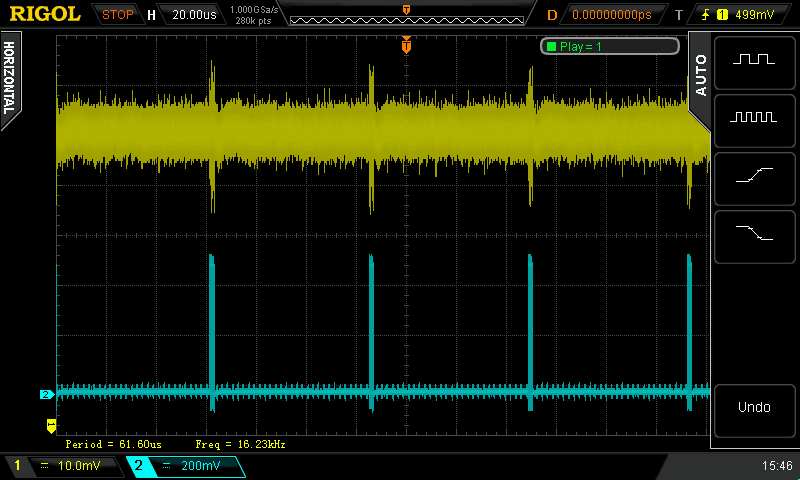Pasky
Fug:DDDDD,
- Joined
- May 5, 2013
- Posts
- 2,844
The vertical bar "fix" by putting caps between vcc and ground does not fix the center bar, it is just reducing it to the point of not being able to see it on most displays. See my comments on ghosting visibility in my posts above. Like the ghosting HDTV's can also reduce the center bar via DNR, which is what I see people using in test videos for that method online. The vertical bar is caused by noise on the PCB, this is why sticking a cap between VCC and ground reduces the issue. I have also tried this, and like the ghosting problem, is still visible on some TV's/monitors. The RGB bypass is the one current known way to get rid of the center bar entirely.
The big thing to understand when interference is involved in the old game systems is that just because it is not visible on your setup does not mean it wont be there for someone else. The goal is to actually fix the problems and not just mask them. One of my biggest pet peeves when the PC10 PPU was the big deal were modders claiming to have jailbar free systems. This was not correct, they simple did not EXPERIENCE the issue with their display/setup but the problem was still there. Drakon was a big example of this. He claimed his mods were jailbar free but every system of his I have seen on an actual RGB monitor (using RGB or S-Video) were riddled with jailbars (far worse than anything I ever did). Caps between VCC and ground is not a new solution, its been used across all the game systems to reduce interference such as jailbars and the vertical bar in the SNES. All this does is reduce it significantly but its not solving the problem.
Caps wont fix the ghosting issue, all they will do is blur the picture enough to where you cant see it. You would need some sort of filter to fix the ghosting issue. If I remember correctly Tim Worthington was working on a device that would filter the jailbars out of a Genny completely, maybe this will work for the SNES ghosting once/if it is released. The XRGB and HDTV are processing the image so that is not proof the problem is fixable by modding the SNES itself. It just shows you can stick it through some sort of external filter and scrub the problem out.
I've looked into the SNES vertical bar issue. It's caused by the DRAM refresh on the memory. When the DRAM refresh occurs, there's a spike on the VCC lines of the PPU (PPUs when it's a 2 PPU model) and CPU that introduces noise into the chips. I've looked into this extensively and I've scoped it as well:
Channel 1 [Yellow]: PPU2 Vcc [Pin 5]
Channel 2 [Blue]: Dram Refresh [Pin 40 CPU]

20mV @200ns:

Not to be the bearer of bad news, but bypassing the encoder also doesn't fix it, it simply 'band-aids' the problem. The bar gets progressively worse the more power you draw from the system. You can see it very prominently if you were to use a gamesaver+ & a SD2SNES flashcart at the same time (which draws about 600mA~). A regular Yoshi's Island cart through RF may also make it visible since last time I measured the power draw when using that cart on a snes was 450mA~ (normal carts only draw about 320-350mA~ iirc, I did tests vs real carts vs sd2snes, vs snes powerpak a while back). I've played around with this several times, checking both through CRT, LCD, & a Capture device across several snes systems. Including some older models which have TWO vertical bars (middle and one on the edge of the screen).
The only way to completely remove it, is to put a low pass filter on both the CPU and PPU's vcc lines (all of them). Throwing a giant reservoir cap, of about 1000uF between the 5V and GND on the 7805 also helps tremendously. Even after doing this, the DRAM spike still occurs, however it isn't nearly as significant, but the bar will no longer be visible on any display with the low pass filters installed.
Simply putting the reservoir cap on the regulator without the low pass filters will significantly reduce the bar, but will still have it faintly visible.
And I 100% agree with you on the PPU-10 with the NES. I've seen numerous people say they have no bars on theirs, but it's just that it wasn't visible on their display. When I look at the NES RGB via a PEXHDCAP (which is extremely sensititve to noise) I get much more prominent jailbars than my CRT's or LCD's.
I've had 2 of them and both had jailbars, one on an AV famicom, the other on a USA top loader. Nothing I tried worked, and the VCC lines going into the PPU's were extremely noisey as were the RGB lines. I gave up trying to reduce the bars after running the power lines through a pi filter, and various other methods to reduce the noise. Nothing worked, and don't even mention Drakon's stupid snake oil solutions, that guy is just full of shit. I think it's just a bad PCB design and ground bounce was causing it. The AV Famicom had them much worse surprisingly.
Last edited:

 if you wish) suck horribly compared to Plasmas and CRT, so I'm still sticking with CRT's until OLED becomes viable). Nevertheless, it kinda makes sense what some say about the 2chippers on HDTVs.
if you wish) suck horribly compared to Plasmas and CRT, so I'm still sticking with CRT's until OLED becomes viable). Nevertheless, it kinda makes sense what some say about the 2chippers on HDTVs.